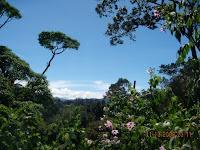It was typical weather on a cloud forest afternoon: a streak of sun poking through the clouds once every twenty minutes, haze blowing through the trees in thick and thin streaks, overall white skies, and a perfect temperature.

But this Saturday afternoon was a little different for the
Lopez family. On April 24th at 4pm, in a tiny
iglesia (church) in a
pueblo called San Ramón del Sur, 22-year-old Hormidas Lopez was being wed to his
prometida, Karen.
The church surprisingly had enough room to fit the Lopez's, their extended family, and their friends. And this made it extra special for us at Costa Rica Outward Bound, too, as we saw most of our homestay families, most of our Tico instructors, and all of their families. In attendance were: Don Hormidas and Doña Flor Lopez (the infamous homestay parents),
 Orlando Zamora
Orlando Zamora and his five kids (homestay family and Land Instructor), Felipe Lopez (former Whitewater Coordinator and River Instructor), Luz Mary Lopez (wife of Land Instructor,
Carlos Grenados, homestay mom) and kids,
Antonio Lopez (Logistics Manager and former River Instructor) with his wife and two kids,
Santiago Lopez (River and Land Instructor) with his wife and kids,
Diego Lopez (River Instructor) with girlfriend Nikki Prevatte (former Piedras Blancas English school teacher),
Pablo Lopez (Land Instructor), and Marielos Lopez with husband and children (homestay family).
The simple and beautiful Catholic ceremony went well.

It was very similar to typical weddings most Americans have attended with less "hooplah." Just as we have all learned on course while staying with the Lopez's, it was also evident that this wedding was about family - not about material possessions. The ceremony had only one groomsman (
padrino, Felipe Lopez) and one bridesmaid (
padrina, Patricia, Felipe's wife) who signed the official wedding documents near the end of the mass. And just before they played the closing song, Felipe announced an open invitation for everyone to come to his new house for a party in celebration of his brother and new sister-in-law.
And come they did.
There seemed to be over one hundred parents, grandparents, kids, neighbors, brothers, sisters, and friends moving about the front lawn and around the one-story neighborhood home.

For the first hour or so, everyone greeted those they hadn't seen in a long time, while the kids ran around jumping and falling. They passed out small cups of Coke for everyone as they chatted. Meanwhile, back in the kitchen, Doña Flor, Felipe, Luz Mary, and a few other sous chefs helped make 10+ gallon pots of chicken/vegetable mixed rice and fresh salsa for chips. Children volunteered to hand out plates to the scattered guests; but dinner plates first went to the bride and groom at their special VIP table covered with a white table cloth and bubbling champagne glasses.
The most amazing thing was seeing so many of the Lopez's all in one place.

It was a beautiful night to talk, dance a little, and talk some more. As in typical wedding tradition, Hormidas and Karen cut the dulce de leche cake together, but they didn't rub it in each other's faces! As the night came to a close, we watched them open gifts. Aside from this, the only other difference between American typical wedding receptions was that everyone changed clothes to be more comfortable at the party.







































